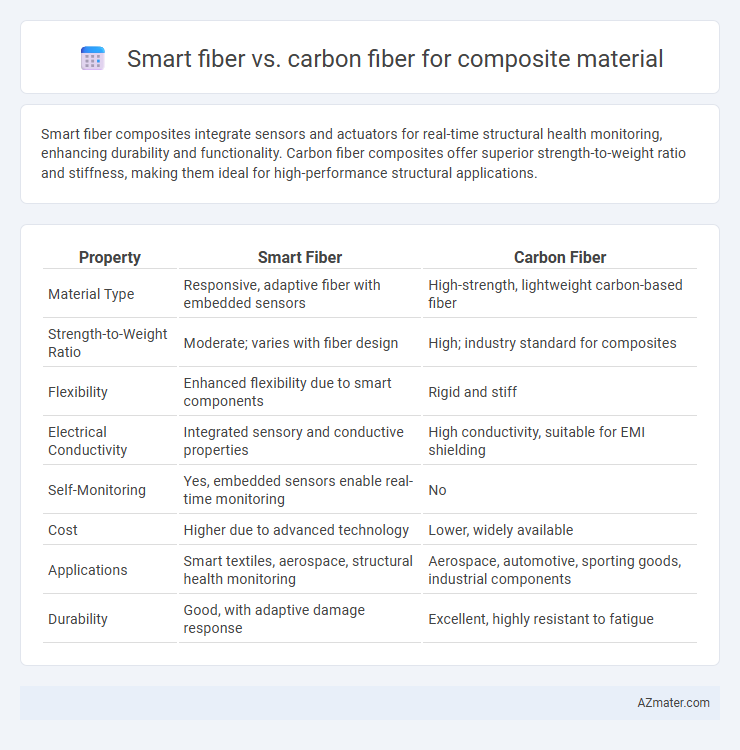Smart fiber composites integrate sensors and actuators for real-time structural health monitoring, enhancing durability and functionality. Carbon fiber composites offer superior strength-to-weight ratio and stiffness, making them ideal for high-performance structural applications.
Table of Comparison
| Property | Smart Fiber | Carbon Fiber |
|---|---|---|
| Material Type | Responsive, adaptive fiber with embedded sensors | High-strength, lightweight carbon-based fiber |
| Strength-to-Weight Ratio | Moderate; varies with fiber design | High; industry standard for composites |
| Flexibility | Enhanced flexibility due to smart components | Rigid and stiff |
| Electrical Conductivity | Integrated sensory and conductive properties | High conductivity, suitable for EMI shielding |
| Self-Monitoring | Yes, embedded sensors enable real-time monitoring | No |
| Cost | Higher due to advanced technology | Lower, widely available |
| Applications | Smart textiles, aerospace, structural health monitoring | Aerospace, automotive, sporting goods, industrial components |
| Durability | Good, with adaptive damage response | Excellent, highly resistant to fatigue |
Introduction to Composite Materials
Composite materials combine two or more constituent materials with distinct physical or chemical properties to create a new material with enhanced characteristics. Smart fibers integrate sensing or responsive capabilities within the composite matrix, enabling real-time monitoring and adaptive performance. Carbon fiber composites offer exceptional strength-to-weight ratios and stiffness, making them ideal for high-performance applications but lack inherent sensing functionality found in smart fiber composites.
What is Carbon Fiber?
Carbon fiber is a high-strength, lightweight composite material composed of thin strands of carbon atoms bonded in a crystalline formation. Known for its exceptional stiffness, tensile strength, and resistance to high temperatures, carbon fiber is widely used in aerospace, automotive, and sporting goods industries. Its ability to provide superior mechanical performance while maintaining low weight makes it a preferred material for advanced composite structures.
What are Smart Fibers?
Smart fibers are advanced composite materials embedded with sensors or responsive elements that enable real-time monitoring and adaptive behavior under mechanical stress, temperature changes, or environmental conditions. Unlike traditional carbon fibers, which primarily offer high strength-to-weight ratios and stiffness, smart fibers integrate functionalities such as self-sensing, self-healing, or shape memory capabilities. These features make smart fibers essential for aerospace, automotive, and civil engineering applications requiring enhanced performance, durability, and structural health monitoring.
Key Properties: Strength, Weight, and Durability
Smart fiber composites exhibit enhanced adaptability through embedded sensors, offering high strength and moderate weight, making them ideal for real-time structural health monitoring. Carbon fiber composites provide superior tensile strength and exceptional lightweight characteristics, achieving optimal strength-to-weight ratios essential for aerospace and automotive industries. While carbon fiber excels in long-term durability and resistance to fatigue, smart fibers prioritize multifunctionality, balancing durability with advanced sensing capabilities in composite applications.
Manufacturing Processes Compared
Smart fiber composites often involve advanced manufacturing methods such as wet spinning, electrospinning, or automated fiber placement to integrate sensors and responsive elements seamlessly, enabling real-time monitoring and adaptive capabilities. Carbon fiber composites predominantly use processes like resin transfer molding (RTM), autoclave curing, or prepreg layup, which focus on achieving high strength-to-weight ratios through precise fiber alignment and resin infusion. While carbon fiber manufacturing emphasizes structural performance and rigidity, smart fiber processes prioritize embedding functionality without significantly compromising mechanical properties.
Sensing and Adaptability Features
Smart fiber composites integrate sensory capabilities through embedded fibers such as piezoelectric or optical fibers, enabling real-time structural health monitoring and adaptive response to environmental changes. Carbon fiber composites offer exceptional strength-to-weight ratio but lack intrinsic sensing properties unless combined with smart fibers or sensors. The incorporation of smart fibers within carbon fiber matrices enhances composite adaptability, providing both high mechanical performance and multifunctional sensing features essential for advanced aerospace and automotive applications.
Application Areas: Automotive, Aerospace, and Beyond
Smart fiber composites integrate sensors and actuators within the material, revolutionizing applications in automotive and aerospace industries by enabling real-time structural health monitoring and adaptive response to external stresses. Carbon fiber composites dominate in aerospace and high-performance automotive sectors due to their superior strength-to-weight ratio and stiffness, critical for fuel efficiency and performance optimization. Beyond these fields, smart fiber technology expands into civil infrastructure and wearable devices, offering intelligent materials that enhance safety and functionality through embedded sensing capabilities.
Cost Analysis: Production and Lifecycle
Smart fiber composites typically have higher initial production costs due to advanced sensing capabilities and complex manufacturing processes, whereas carbon fiber composites benefit from established mass production techniques reducing unit costs. Lifecycle expenses for smart fiber materials may be lower because integrated sensors enable real-time damage detection and predictive maintenance, extending service life and minimizing downtime. Carbon fiber composites, despite lower upfront costs, often incur higher inspection and repair costs over time due to lack of embedded health monitoring systems.
Environmental Impact and Sustainability
Smart fiber composites offer enhanced recyclability and lower environmental footprints compared to traditional carbon fiber materials, which often rely on energy-intensive manufacturing processes and non-biodegradable resins. Carbon fiber composites pose challenges in waste management due to their durability and limited recycling options, contributing to landfill accumulation and increased carbon emissions. Innovations in smart fiber technology emphasize sustainable raw materials and eco-friendly production techniques, promoting circular economy principles in composite applications.
Future Trends in Smart and Carbon Fiber Composites
Future trends in smart fiber composites emphasize integration of sensors and self-healing capabilities, enhancing structural health monitoring and durability in aerospace and automotive applications. Carbon fiber composites continue evolving with advancements in nanotechnology, improving strength-to-weight ratios and conductivity for lightweight electric vehicle components and renewable energy structures. Hybrid composites combining smart fibers with carbon fibers are emerging to provide multifunctional properties, balancing performance, cost, and sustainability in next-generation materials.

Infographic: Smart fiber vs Carbon fiber for Composite material
 azmater.com
azmater.com